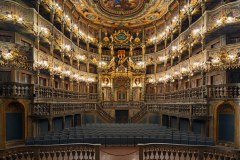Carlo Vistoli
September 2025 | ||||||
|---|---|---|---|---|---|---|
Mo | Tu | We | Th | Fr | Sa | Su |
Carlo Vistoli - Opera Antica (Concert)
Leonardo García Alarcón | Cappella Mediterranea
Margravial Opera House Bayreuth
Whether Paris, or London, Moscow, Venice, Berlin, Salzburg or Vienna – the Italian countertenor Carlo Vistoli guests regularly at the major opera houses of the world and has made an outstanding name for himself especially in the seventeenth- and eighteenth-century repertoire. In his cleverly compiled concert programmes, he focuses time and again also on unknown works, his virtuosic coloratura and tonal beauty breathing new life into long forgotten operatic heroes from the cradle of operatic history.
In the concert Opera Antica Carlo Vistoli and the Cappella Mediterranea under Leonardo Garcia Alarcón take us to Italy of the mid-seventeenth century, where the still young genre of the opera was scaling its first summits of achievement. Composers like Monteverdi, Cesti, Cavalli and Stradella had hardly any existing traditions to latch onto and had to reinvent this innovative configuration of theatre, song, dance and music almost from scratch. The works yielded by this were to shape the history of music theatre permanently: in the cheerful “Ombra mai fu” from Cavalli’s Xerse or the yearning love lament “E pur io torno” from Monteverdi’s L’incoronazione di Poppea, everything is germinated here that subsequent periods would reap as profound musical emotions. And when have we ever heard in later times such a dramatic, poignant and yet comedic madness scene as in Stradella’s comic opera Il Trespolo tutore?
Program and cast
Carlo Vistoli - Countertenor
Leonardo García Alarcón - Conductor and Harpsichord
Cappella Mediterranea Orchestra in Residence of the Bayreuth Baroque Opera Festival 2025
PROGRAMME
Francesco Cavalli (1602–1676)
“Ohimè, che miro – Misero Apollo”
Lamento of Apollo from Gli amori di Apollo e Dafne
“Ombra mai fu”
Aria of Xerse from Il Xerse
“Uscitemi dal cor, lacrime amare”
Lamento of Idraspe from Erismena
“Per eccesso d’affetto – Che ti diss’io?“”
Aria of Iarba from La Didone
“Erme e solinghe cime – Lucidissima face”
Aria of Endimione from La Calisto
Antonio Cesti (1623–1669)
“Qual profondo letargo – Care note amorose – Fissa il chiodo, o Fortuna”
Aria of Alidoro from L’Orontea
Claudio Monteverdi (1567–1643)
“E pur io torno”
Aria of Ottone) from L’incoronazione di Poppea
“I miei subiti sdegni”
Aria of Ottone) from L’incoronazione di Poppea
Alessandro Stradella (1643–1682)
From Il trespolo tutore
“Oh, quanti soli – Oblio, che lento e tacito – Su, dunque, fuggite”
Aria of Nino from Il Trespolo tutore
“Tarapà, tarapà, tarapà – Fa’ la nanna, Nino mio – Venghino in questo circolo”
Nino’s Mad Scene from Il Trespolo tutore
Margravial Opera House
It was built according to plans designed by the French architect Joseph Saint-Pierre (ca. 1709 – 1754), court builder of the Hohenzollern margrave Frederick of Brandenburg-Bayreuth and his wife Princess Wilhelmine of Prussia. It was inaugurated on the occasion of the marriage of their daughter Elisabeth Fredericka Sophie with Duke Charles Eugene of Württemberg.
The wooden interior was designed by Giuseppe Galli Bibiena (1696 – 1757) and his son Carlo from Bologna in an Italian Late Baroque style. The box theatre is completely preserved in its original condition, except for the curtain which was taken by Napoleon's troops on their march to the 1812 Russian campaign. The prince box was seldom used by the art-minded margravial couple, who preferred a front-row seat.
Princess Wilhelmine, older sister of the Prussian king Frederick the Great, had established the margravial theatre company in 1737. In the new opera house she participated as a composer of opera works and Singspiele, as well as an actor and director. Today she features in a sound-and-light presentation for tourists. After her death in 1758, performances ceased and the building went into disuse, one reason for its good conservation status.
More than one hundred years later, the stage's great depth of 27 metres (89 ft) attracted the composer Richard Wagner, who in 1872 chose Bayreuth as festival centre and had the Festspielhaus built north of the town. The foundation stone ceremony was held on 22 May, Wagner's birthday, and included a performance of Beethoven's Symphony No. 9, directed by the maestro.
Parts of the 1994 biopic Farinelli were filmed in the Opera House. The theatre was the site of the annual Bayreuther Osterfestival until 2009. Each September from the year 2000 to 2009, the theatre also hosted the Bayreuth Baroque festival, with performances of early operatic rarities. The 2009 festival included performances of Andrea Bernasconi's festa teatrale, L'Huomo, to a libretto by the Margravine Wilhelmine.
The theatre closed between October 2012 for extensive refurbishment and redevelopment and reopened 12 April 2018.

 EN
EN DE
DE IT
IT FR
FR ES
ES RU
RU JP
JP RO
RO
 Seating plan
Seating plan 
